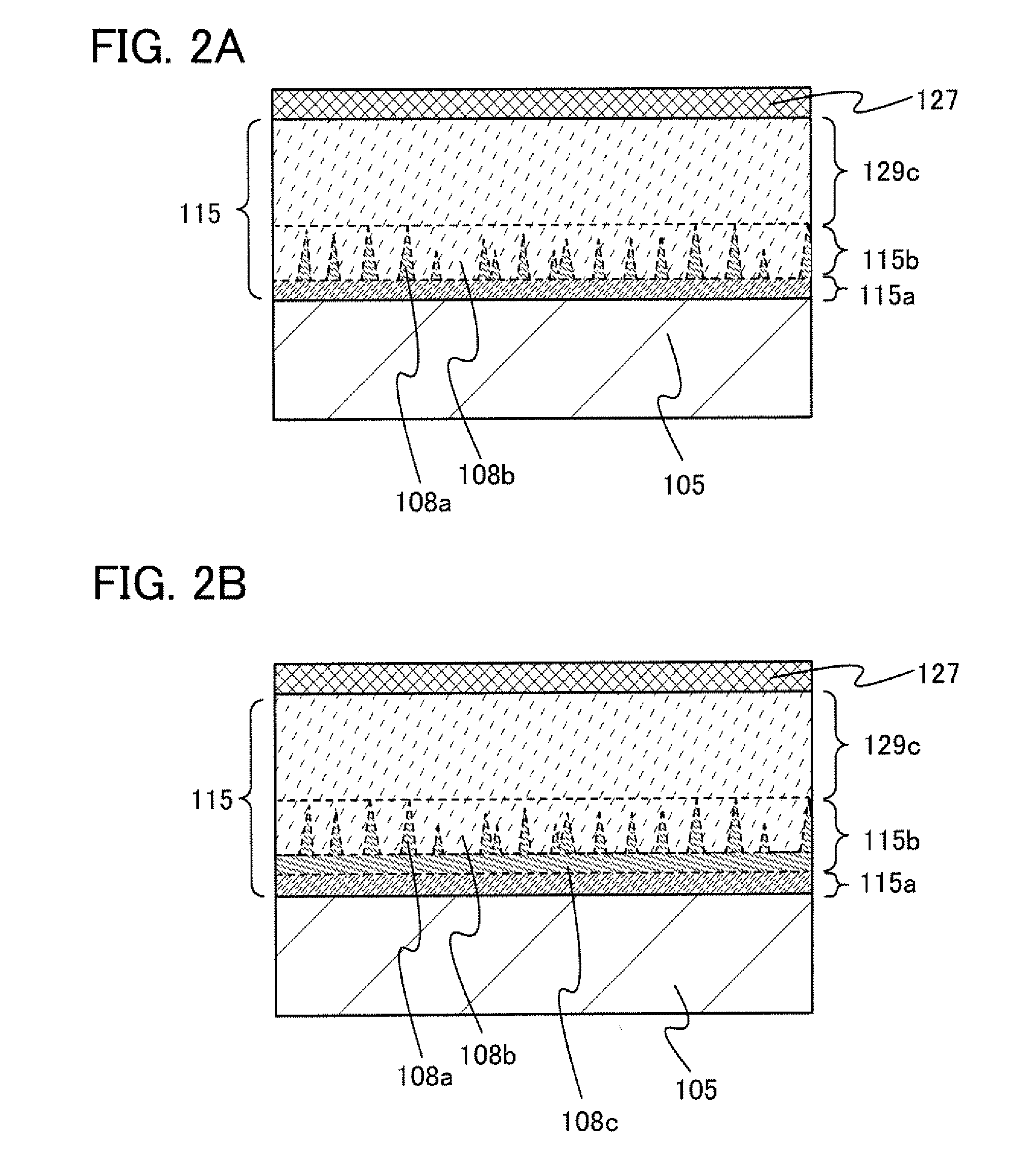Thin film transistor
a transistor and thin film technology, applied in the field of field-effect transistors, can solve the problems of high manufacturing cost, inability to obtain sufficient switching characteristics, and low field-effect mobility and small on-current, and achieve the effect of small off-current and high productivity
- Summary
- Abstract
- Description
- Claims
- Application Information
AI Technical Summary
Benefits of technology
Problems solved by technology
Method used
Image
Examples
embodiment 1
[0053]FIG. 1 is a cross-sectional view of an embodiment of a thin film transistor. The thin film transistor illustrated in FIG. 1 includes a gate electrode 103 over a substrate 101, a semiconductor layer 115 over a gate insulating layer 105, impurity semiconductor layers 127 serving as source and drain regions which are in contact with part of the upper surface of the semiconductor layer 115, and wirings 125 in contact with the impurity semiconductor layers 127. The semiconductor layer 115 includes a microcrystalline semiconductor layer 115a, a mixed layer 115b, and a layer 129c containing an amorphous semiconductor, which are stacked in sequence over the gate insulating layer 105.
[0054]As the substrate 101, a glass substrate, a ceramic substrate, a plastic substrate which has high heat resistance enough to withstand a process temperature of this manufacturing process, or the like can be used. In the case where the substrate does not need a light-transmitting property, a metal subst...
embodiment 2
[0124]In this embodiment, a method for manufacturing the thin film transistor described in Embodiment 1 will be described with reference to FIGS. 12A to 12C, FIGS. 13A to 13C, and FIGS. 14A-1 to 14B-2.
[0125]It is preferable that all thin film transistors formed over the same substrate have the same conductivity type because the number of manufacturing steps can be reduced. Therefore, in this embodiment, a method for manufacturing an n-channel thin film transistor is described.
[0126]First, a manufacturing process of the thin film transistor illustrated in FIG. 1 is described below.
[0127]As illustrated in FIG. 12A, a gate electrode 103 is formed over a substrate 101.
[0128]Then, a gate insulating layer 105 is formed so as to cover the gate electrode 103. After that, a first semiconductor layer 106 is formed.
[0129]The gate electrode 103 can be formed in such a manner that a conductive layer is formed over the substrate 101 using the material given in Embodiment 1 by a sputtering method ...
embodiment 3
[0176]In this embodiment, a method for manufacturing a thin film transistor, which is different from that in Embodiment 2, will be described with reference to FIGS. 12A to 12C, FIGS. 15A to 15C, and FIGS. 16A and 16B.
[0177]As in Embodiment 2, a gate electrode 103 is formed over a substrate 101. Then, a gate insulating layer 105 is formed so as to cover the gate electrode 103, and a first semiconductor layer 106 is formed (FIG. 12A). Next, as in Embodiment 2, crystals are grown from the first semiconductor layer 106, whereby a second semiconductor layer 107 (a mixed layer 107b and a layer 107c containing an amorphous semiconductor) is formed. Then, an impurity semiconductor layer 109 is formed over the second semiconductor layer 107 (FIG. 15A). After that, a resist mask (not illustrated) is formed over the impurity semiconductor layer 109.
[0178]Next, with the use of the resist mask, the second semiconductor layer 107 and the impurity semiconductor layer 109 are etched. By this step, ...
PUM
 Login to View More
Login to View More Abstract
Description
Claims
Application Information
 Login to View More
Login to View More - R&D
- Intellectual Property
- Life Sciences
- Materials
- Tech Scout
- Unparalleled Data Quality
- Higher Quality Content
- 60% Fewer Hallucinations
Browse by: Latest US Patents, China's latest patents, Technical Efficacy Thesaurus, Application Domain, Technology Topic, Popular Technical Reports.
© 2025 PatSnap. All rights reserved.Legal|Privacy policy|Modern Slavery Act Transparency Statement|Sitemap|About US| Contact US: help@patsnap.com



